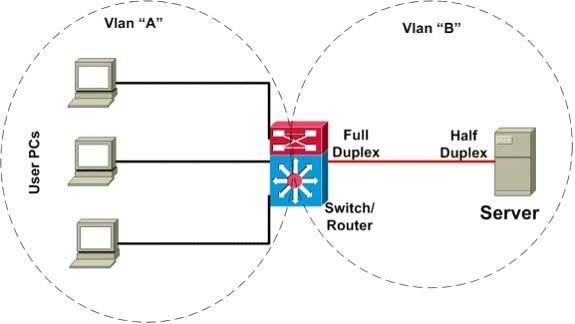Slow Inter VLAN Forwarding
Question
Which statement about slow inter VLAN forwarding is true?
Answers
Explanations
Click on the arrows to vote for the correct answer
A. B. C. D. E.E
Common Causes of Slow IntraVLAN and InterVLAN Connectivity The symptoms of slow connectivity on a VLAN can be caused by multiple factors on different network layers. Commonly the network speed issue may be occurring on a lower level, but symptoms can be observed on a higher level as the problem masks itself under the term "slow VLAN". To clarify, this document defines the following new terms: "slow collision domain", "slow broadcast domain" (in other words, slow VLAN), and "slow interVLAN forwarding". These are defined in the section Three Categories of Causes, below.
In the following scenario (illustrated in the network diagram below), there is a Layer 3 (L3) switch performing interVLAN routing between the server and client
VLANs. In this failure scenario, one server is connected to a switch, and the port duplex mode is configured half- duplex on the server side and full-duplex on the switch side. This misconfiguration results in a packet loss and slowness, with increased packet loss when higher traffic rates occur on the link where the server is connected. For the clients who communicate with this server, the problem looks like slow interVLAN forwarding because they do not have a problem communicating to other devices or clients on the same VLAN. The problem occurs only when communicating to the server on a different VLAN. Thus, the problem occurred on a single collision domain, but is seen as slow interVLAN forwarding.

Three Categories of Causes -
The causes of slowness can be divided into three categories, as follows:
Slow Collision Domain Connectivity
Collision domain is defined as connected devices configured in a half-duplex port configuration, connected to each other or a hub. If a device is connected to a switch port and full-duplex mode is configured, such a point-to-point connection is collisionless. Slowness on such a segment still can occur for different reasons.
Slow Broadcast Domain Connectivity (Slow VLAN)
Slow broadcast domain connectivity occurs when the whole VLAN (that is, all devices on the same VLAN) experiences slowness.
Slow InterVLAN Connectivity (Slow Forwarding Between VLANs) Slow interVLAN connectivity (slow forwarding between VLANs) occurs when there is no slowness on the local VLAN, but traffic needs to be forwarded to an alternate VLAN, and it is not forwarded at the expected rate.
Causes for Network Slowness -
Packet Loss -
In most cases, a network is considered slow when higher-layer protocols (applications) require extended time to complete an operation that typically runs faster.
That slowness is caused by the loss of some packets on the network, which causes higher-level protocols like TCP or applications to time out and initiate retransmission.
Hardware Forwarding Issues -
With another type of slowness, caused by network equipment, forwarding (whether Layer 2 [L2] or L3) is performed slowly. This is due to a deviation from normal
(designed) operation and switching to slow path forwarding. An example of this is when Multilayer Switching (MLS) on the switch forwards L3 packets between
VLANs in the hardware, but due to misconfiguration, MLS is not functioning properly and forwarding is done by the router in the software (which drops the interVLAN forwarding rate significantly).
Inter VLAN forwarding refers to the process of forwarding traffic between different VLANs in a network. In some cases, this forwarding may appear slow or delayed, which can impact network performance. Let's review the options provided to determine which statement about slow inter VLAN forwarding is true.
A. The VLAN is experiencing slowness in the point-to-point collision-less connection.
This statement is not entirely accurate. Point-to-point connections, such as those provided by fiber-optic or Ethernet links, typically do not experience collisions, which can slow down network performance. While there may be issues with the connection itself, such as a faulty cable or damaged hardware, these issues would likely impact all VLANs, not just the inter VLAN forwarding.
B. The VLANs are experiencing slowness because multiple devices are connected to the same hub.
This statement is also unlikely to be the cause of slow inter VLAN forwarding. Hubs are typically considered obsolete networking technology and are not commonly used in modern networks. Additionally, even if multiple devices were connected to the same hub, this would not directly impact the performance of inter VLAN forwarding.
C. The local VLAN is working normally, but traffic to the alternate VLAN is forwarded slower than expected.
This statement is the most likely to be true. In some cases, the VLAN responsible for forwarding traffic may be working as expected, while the alternate VLAN may be experiencing delays. This can be caused by various factors, including network congestion, misconfigured network devices, or incorrect VLAN tagging.
D. The entire VLAN is experiencing slowness.
This statement is unlikely to be true, as inter VLAN forwarding issues typically only impact traffic between specific VLANs. If the entire VLAN were experiencing slowness, it would suggest a larger network issue, such as insufficient bandwidth or a widespread hardware failure.
E. The VLANs are experiencing slowness due to a duplex mismatch.
While a duplex mismatch can impact network performance, it is unlikely to be the cause of slow inter VLAN forwarding. Duplex mismatches typically occur between network devices that are directly connected to each other, rather than between devices on different VLANs.
In conclusion, the most accurate statement about slow inter VLAN forwarding is that the local VLAN is working normally, but traffic to the alternate VLAN is forwarded slower than expected.
